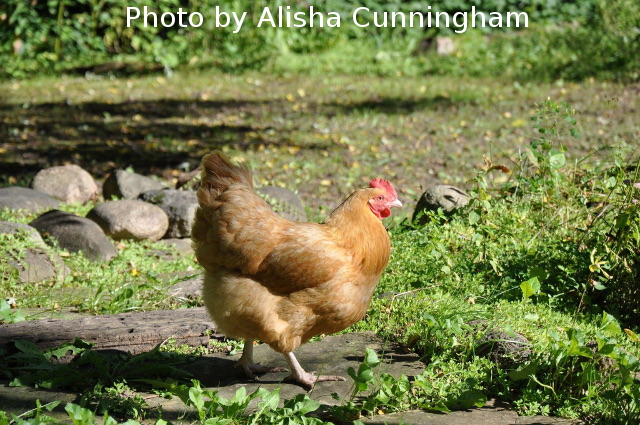 With summer approaching, you’ll need to help your chickens stay cool, at least in the warmer parts of the country.
With summer approaching, you’ll need to help your chickens stay cool, at least in the warmer parts of the country.
Unlike humans, chickens don’t sweat, but like humans they depend on evaporation to stay cool – by panting. As they pant, moisture within the chickens’ lungs evaporates and is moved out of their bodies. This is also why it’s harder for them, like us, to stay cool when it’s humid.
The best way to know if your chickens are getting too hot is to watch their behavior.
Are they panting? Are they hanging their wings out a little distance a way from their bodies? These are early signs that they’re having to work harder to stay cool. If they’ve become listless or their breathing has become labored, then they’re experiencing heat stress – that’s harmful to them. Hens that aren’t able to stay cool enough will slow and stop their laying, and chickens that get too hot or stay hot for too long can die from heat stress.
So, how do we keep them cool?
Adapted breeds
The first thing is a decision you make before you get chickens: to start with adapted breeds, that is, breeds that are well-suited to your climate.
There are a lot of different chicken breeds, and each breed was originally developed for a specific purpose. Some breeds do better in warm weather, and some do better in cooler climates.
Mediterranean breeds, such as Leghorns and Minorcas are a good choice for hot areas. For more suggestions, see our Chicks Page.
Next, let’s consider housing.
Housing
First, make sure your birds have plenty of space. Chickens have a natural body temperature of 107° (F). They put off a lot of heat and moisture. Put too many chickens in too small of an area, and it will be difficult for them to stay cool. For full size birds, we recommend a minimum of 4 square feet per bird.
Next, make sure the coop is well-ventilated. Good airflow will help to move out both the moisture and the heat put off by the birds. If you’re not able to get enough airflow with natural ventilation, consider creating a breeze with a fan.
Third, when possible, position the coop and the run under the shade of a tree or a building or other structure. Placing the coop and run beneath a shade tree can make a big difference in temperature. Also, position the coop where it will catch a breeze.
Water
It’s always important to give your chickens plenty of access to fresh water. But in hot weather, this is even more critical.
Put waterers in the shade so that the water will stay cool. Chickens may be reluctant to go out into the hot sun to get a drink – so having water in the shade is critical. Keep the water fresh and clean, and fill waterers with cool water if possible. On excessively hot days, replace warm water with cooler water again during the hotter part of the day. Your chickens will drink more water when the water is cool, and the cooler water will be more effective at helping them stay cool. If needed, you can even add some ice.
Be Observant & Be Creative
Checking on your chickens every day and watching their behavior is one of the best ways you can discover things before they turn into problems. If you notice that your chickens have plenty of water and shade, but they still seem hot and are sitting, panting in the shade, or if you notice that they’re not drinking as much water as you would expect, you may have to do a little detective work.
I recently heard an account of someone who was raising chickens in a hot, dry area. They were using nipple waterers, and there was ample water at all times. But still, the birds did not seem to be drinking enough water. Under most circumstances, nipple waterers work well, but the person keeping the chickens discovered that when it’s hot and the chickens are panting, they aren’t able to operate the nipple waterers well, so they weren’t getting as much water as they needed. When they’re not panting, the nipple waterers work well. The solution was very simple – they added a water fount in the shade so that the chickens could quench their thirst there and make use of the nipple waterers.
Small Things Make a Big Difference
In the heat of the day, chickens aren’t as active as when it’s cooler. If they have to cross a hot, sunny area to reach a waterer, they may not drink as much water as they should. Simply adding another waterer in the shade near them or repositioning the waterer so that it’s more easily accessible can make a big difference in how much water they drink and how well-hydrated they stay.
At one point, as I was writing this article, I sat and watched our chickens for a few minutes. In a chicken tractor nearby two Black Stars were panting a little. The large thermometer in the shade of our porch read 97° (F). I went out to take a closer look at the hens.
As I got closer, I found that the shade provided by the coop was mostly falling outside the chicken tractor on an area that the hens couldn’t reach, so it wasn’t doing them much good. The chicken tractor was parked right next to a tree, but the shade from it wasn’t landing inside the coop. I moved the coop a few feet and turned it 90° so that the shade from the coop’s roof would fall on the grassy run where the hens were, and they immediately got up and began foraging again in the grass.
Sometimes, something as simple as repositioning a coop or placing a layer of straw or fabric on the top of the run can give your chickens all the shade they need. In our garden, we have difficulty with Bermuda grass. To manage the Bermuda requires pulling out as much as possible of the roots. Bermuda is very apt to root again, so I don’t like to put it directly into the compost heap or leave it on the soil in or near the garden even once pulled. Instead, often I will lay the uprooted Bermuda on top of one of the chicken runs. There it provides cool shade (better than a piece of tin would) and this keeps the Bermuda off the ground where it will dry out fully and not be able to take root again.
This covers some of the basics. What kinds of things do you to keep your chickens cool?



I like to wet the ground in their lots. I find that they like to lay on the cookies moist ground.
There is a mesh tarp for reflecting sun but allowing the breeze to come through. I use it for my dogs & the chickens on the west side to reflect that hot, afternoon sun & provide shade. It is called “solar crate canopy” http://www.amazon.com There is another product called “heavy duty shade net tarp” which I may try if the ones I have don’t hold up over time..
I would appreciate it is some of the posters who use misters could state which ones they’ve found useful. I’m not a do-it-yourselfer.
We built our chicken house to stay warm in the winter.
We later built an addition on it of wire with a tin top. We put tin of the sides for our growing flock to keep them warm in the winter, but in the summer, we can take the tin off the sides to keep them cool and a nice breeze blowing through. The original chicken house has windows of screen but also closing doors for winter. So in summer we open the doors to make a breeze in the laying house.
Our chickens get out every morning and chase bugs and whatever they want to do. In summer they dig holes under the shade trees, so at night when we put them up, we turn their water tubs over in those holes and by morning they are nice and cool. Also we overfill the water tubs in the summer several times a day for them to have damp soil. We keep a shallow tub filled for them to stand in. They stand in line for that.
We live in hot, dry Southern California. Installing small hose misters, available at any hardware store, helps humidify and cool the air in the chicken run.
Out here at our coop in the AZ desert heat the temps can get up to 115°f+ humidity during the summer months! We have learned that putting misters on our coop and its lg fenced in yard that our peacocks live in Our chickens can wander in/out the other side with a full coop that gives them access to the full yard and trees with water running throughout our sun drenched property. The peacocks have the misters also and we have them situated so that the breeze comes through and acts like a air conditioner, plus access to fresh cool water 24/7 and give them fresh fruit during the summer along with veggies. During the past couple years loss has been kept to the very old 10+ chickens, and a few couple months old to owls and hawks. We also use misters on our patio for our cat colony that helps keep pests to a minimum. We also are on a well water so it does make a difference.
What misters do you use? I’m not a do-it-yourselfer. Thanks.
I spent $30 two years ago at True Value and ran a 1/2″ plastic pipe with misters every 3 feet on the 21 foot southern exposure of my run. They spend all day under it, as it lowers the temperature about 12 degrees in that vicinity. I live in Kingman, AZ. where it has already been over 100 degrees and will easily hit 107 for most of the summer. Ain’t lost a single chicken and they don’t spread their wings or “gap” their beaks. They stay real happy.
Hi Wayne. Can you provide more details on how to set the mister up & what to use?
Yes. Use 1/2 inch PVC pipe in 21 ft length. Misters come in a 5-pack for $21. Set them up so they are 3 feet above the ground and on the south side of the enclosure. Glue the misters (they are each a 1/2 ” PVC coupling, OrbitAZ by name-brand) about 3 feet apart. Part can be seen on-line at True Value.com. Type in the Orbit name. My line is secured to my chain-link run. Let the glue set overnight and put it together the next day. One end is capped off and the other end has a threaded fitting on it and a 1/2″ pipe to hose thread male fitting. I have a garden hose hooked up to it and I turn the water on when it hits 90 degrees (about noon here). Works great, and is real cheap.
We live in Wisconsin. As we always say here “if you don’t like the weather wait a minute or two it will change.” When it gets hot and humid here in the summer I will water down the chicken run and then hose down the chicken coop. Both make a world of difference in the comfort of the chickens. The run and coop are shaded by a big tree in the middle of the afternoon so watering down the sandy ground makes it a bit cooler, which the chickens really like.
Heat is a huge issue where I live. Today is 104 and it will get hotter by August. My backyard coop I keep cool by using a shade tarp from my patio roof to my fence shading the coop throughout the day. I also have a couple of hens in smaller coop which I lay a wet beach towel over to provide shade and coolness as the breeze passes through the wet towel. It seems to really help. I also will hose down the wood coop with cold water and feed my hens frozen peas and other frozen veggies which they seems to really like in the hot days of summer. Hope this helps those with backyard flocks.
I live in Mississippi and it is hot and humid and we have their watering pan is an oil pan from the dollar tree. I place a frozen gallon jug in there every day and this cools the water and they really enjoy the cool drink.
Thank you for the ideas. I implement most of them but the straw on top is perfect for me. I’m sure you just made my chickens a lot happier.
Selecting Suitable breeds for my area is a challenge because we can have both hot, humid summers AND cold winters(negative digits for the daily high!). Fortunately my property is mostly wooded so that Summer shade won’t be a problem. The birds will have most of a half acre which will be at least 3/4 shaded.
My chickens are in a chain link dog kennel. I have box fan hanging on the outside of the kennel. Will that help? I use the nipple watering system. The enclosure is under a tree with a white metal roof. Thier nesting boxes are surrounded with fence pickets thus giving them more shaded area. They are not showing any signs of heat problems yet but in Texas it is coming! Can I do anything else to help them?
I have a backyard flock of (5) girls and when they get to hot they love getting a cool bath. The other thing they like is walking through a water mister that I hook up to a garden hose. This may not work for everyone; my girls are used to having baths.
I live in beautiful East Texas, and it’s already nearing 100 degrees here. ….
I do several things that help our chickens stay cool:
1. As the article from McMurray suggested, I have my coop located in the trees. Since the coop is designed to move, I try to keep it over enough grass to interest the chickens and provide a cool place to lay down in during the hot afternoon. Having said that, our birds manage to eliminate any grass in their immediate exercise area (within the enclosure) within 2 days….so my husband built several portable chicken runs that give the birds plenty of opportunity to stay in the shade, while exploring their yard.
2. I feed the hens watermelon….just opening the rind and letting them peck away at the cold interior of the melon.
3. I fill and freeze large ice cube trays, adding whole kernel corn or seeds….then allow the birds to peck the cubes until they ‘find’ the goodies. This allows the cubes to melt a little, which provides some cool moist ground for them to relax in.
4. On extremely hot days (100+), I provide a ice cold foot bath…..using an old basin. Once the ice melts down, the birds stand in the water to cool off and enjoy a sip too.
As I posted earlier, I feed my hens frozen peas! This will help coop them as they eat the frozen treats. My girls love them. Good Luck!
hi
I watch for where the hot afternoon sun is. I use a tarp on the side of the pen to block out the sun. Makes a big difference. Also the birds love sitting in those pop up mesh tents.
I have found that if I let a hose dribble in a shady spot my hens gravitate to it and seem to enjoy the cooling water on their feet.
We live in Ricardo, TX which is just south of Kingsville. Today our heat index is 107F. So you can imagine it’s hot for our flock! I have big dish buckets with water that have frozen gallon jugs in the coop. Along with shallow dish pails to cool off their feet. Their run is shaded and coop is well ventilated. I have pictures on my Facebook page. The girls still hold their wings out a little and pant on occasion, but in this heat, they do what they can to stay cool.
I enjoyed your article! Your comment about Bermuda-the-weed-from-hell-Grass provided the very first idea I’ve ever heard of a good use for it. It reminded me of something an “old-timer” said many years ago, to the effect that “You can pull that stuff out and hang it on a “bob-wire” fence fer ten year, an’ if the wind come along an’ blow it off, why it’ll take off a-runnin’ again…”
I cut small watermelons in half and put them in the freezer. On very hot days, I set the melon outside, in the shade with some meal worms sprinkled on top…As the melons defrost, the chickens pick at the cold fruit providing hydration. I also put ice in a shady area…as the ice defrosts, it provides a cool area for the chickens to rest. Frozen blueberries are another treat for them when it is very hot.
Frozen whole kernal corn as a cool treat, lasts longer if you freeze it with a little water in ice cube trays. My girls love it.
I recently heard about freezing whole kernal corn. My chickens love to peck at the ice cubes, to get the corn. I also keep a small kiddie pool with cool water for my ducks and overflow the water to cool down my chickens. I try to add additional cool water, 2-3 times a day, in the Texas heat.